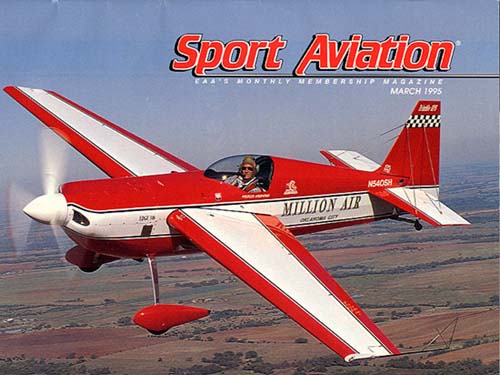
PIREP: Zivko Edge 540

PAGE TWO The final design combined some of the industry's best. John Roncz designed a new airfoil that would have a low stall speed, would corner well and have predictable, well-behaved characteristics at both ends of the envelope. The preliminary wing layout was done by Paul Finn, while Dave Boldenow, a Boeing composite engineer, did the structures. When the prototype popped out of the oven, Zivko loaded it to 20 g's and found a deflection of only a little over four inches. Now that's stiff! The production wing weights 224 pounds and is good for 20 Gs, versus the old wooden 12 G wing that usually weights around 250 pounds.
The wing
was first installed on Joe Olson's Lazer with many more following right
on the heels of that one. Zivko Aeronautic's wing, the Edge ZA-1 is earning
a reputation for giving the Lazer a new lease on life. In fact, Livko even
began custom building airframe components for customers who wanted their
own airplane that incorporated the wing along with a bunch of other modifications
engineered by Zivko. They call their four-cylinder airplane the Edge 360.
Unfortunately, unlimited competition has very definitely become an area where last year's model just won't cut it. Laser's can't make the grade, if nothing else, because they don't have enough power. Every year the factories and specialty shops keep cranking out new designs that climb and roll faster while combining handling that varies from stunningly well balanced to flat-out wierd. Unfortunately, those airplanes at the top of the aerobatic ladder aren't wearing Made in America stickers. They are also carrying more horsepower than can possibly put stuffed into a Lazer sized monoplane. And then there are their staggering price tags. Bill and Judy looked at the track record being established by their wing and decided the next obvious move was to build their own high performance airplane around that wing. They wanted an airplane that could successfully bump heads with Sukhois and Extras. That mean't going to a six cylinder, I0-540 in place of the Lazer's 0-360. There are lots of places in everyone's mechanical life where the only logical solution for a situation is a healthy dose of cubic inches. Or a bigger hammer. By the time Zivko Aeronautics was getting ready to start into their own airplane project, they were already a production shop which had a client list including names like Tinker Air Force base, Leo Loudenslager and a most interesting client named Aurora Flight Sciences. Aurora's products were ultra-high altitude, unmanned aircraft which were aimed at doing all sorts of environmental surveying up where manned aircraft were nearly useless. These aircraft were designed to work between 80,000 and 100,000 feet while carrying payloads that sniffed the atmosphere for bad stuff or could loiter on top a hurricane for most of its life cycle. They measure their loiter times in days, not hours! The current production aircraft, the Perseus B has a loiter time that can be extended up to four complete days. They can do global-scale chemistry surveys over nearly half the earth's circumference in one flight. Obviously these airplanes are special purpose and rely on light wieght and long wings to do their thing. And that's where Zivko Aeronautics comes into the picture. The huge (59 foot) wings wouldn't be possible without composites and Zivko built not only the wings, but all composite components including the tail and fuselage as well.
There are a lot of composite fabrication companies in the world that could build the components, so it says something that Zivko aced-out many much larger companies. With their moves into the big time world of composite engineering, a full-time engineer, Todd Morse (his great grandfather invented the code), was added to the staff along with complete CADCAM capabilities. All of this experience and capabilities were brought to bear on their unlimited bird, the EDGE 540. The heart of any aerobatic airplane is the wing, which in this case is
probably one of the most carefully designed and manufactured wings in the
country. Zivko prides itself in quality control and details. They go so
far as using raw materials that each carry their own verified certifications
which are kept on file for each component made. Each lay-up has its own
sign-up sheet so it can be verified later that it was laid-up at a given
angle, done by a specific individual and signed off as being correct by
an inspector. Every single step from the manufacuring of the raw materials
to the final paint coat is carfully documented and inspected.
|